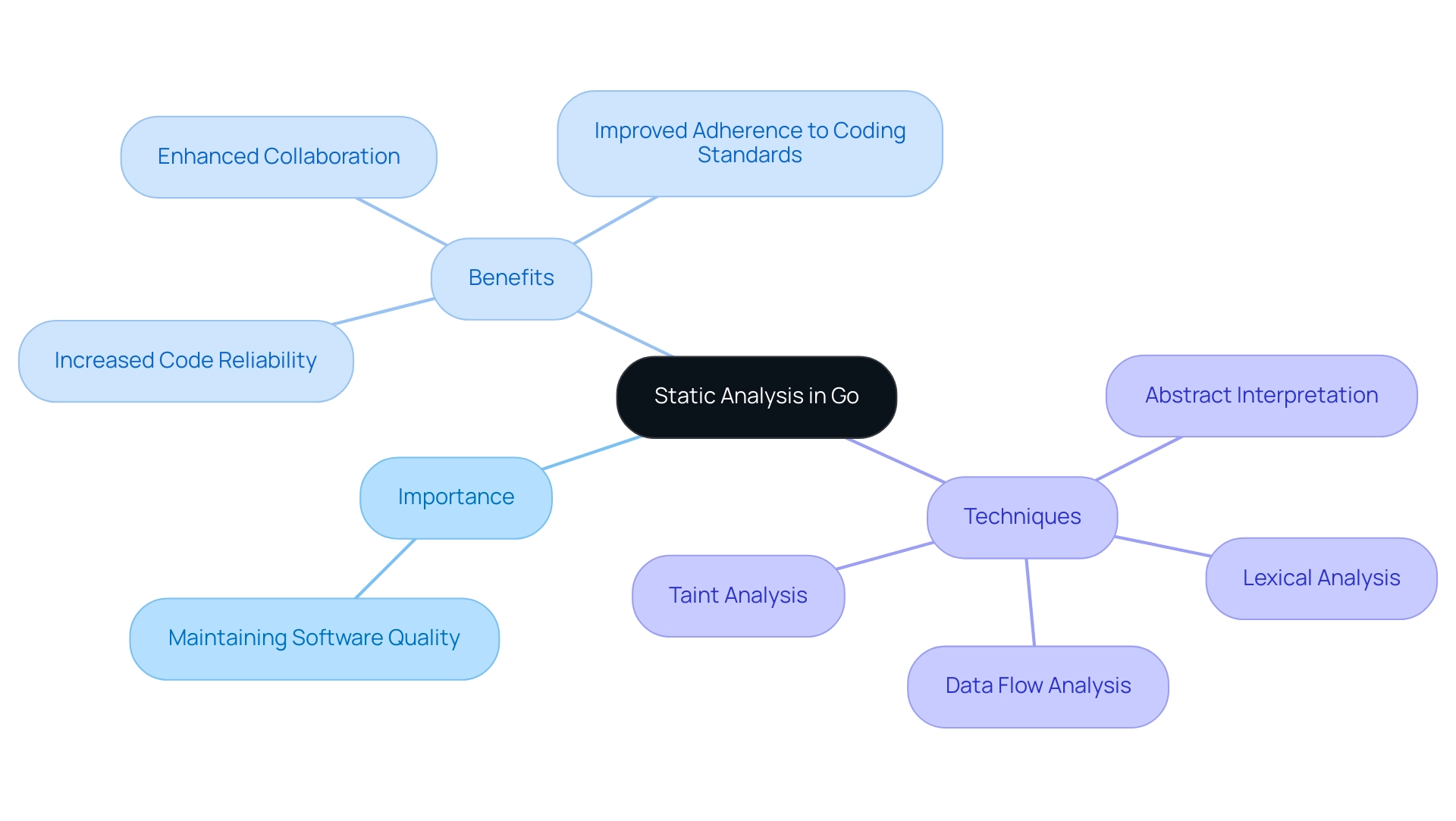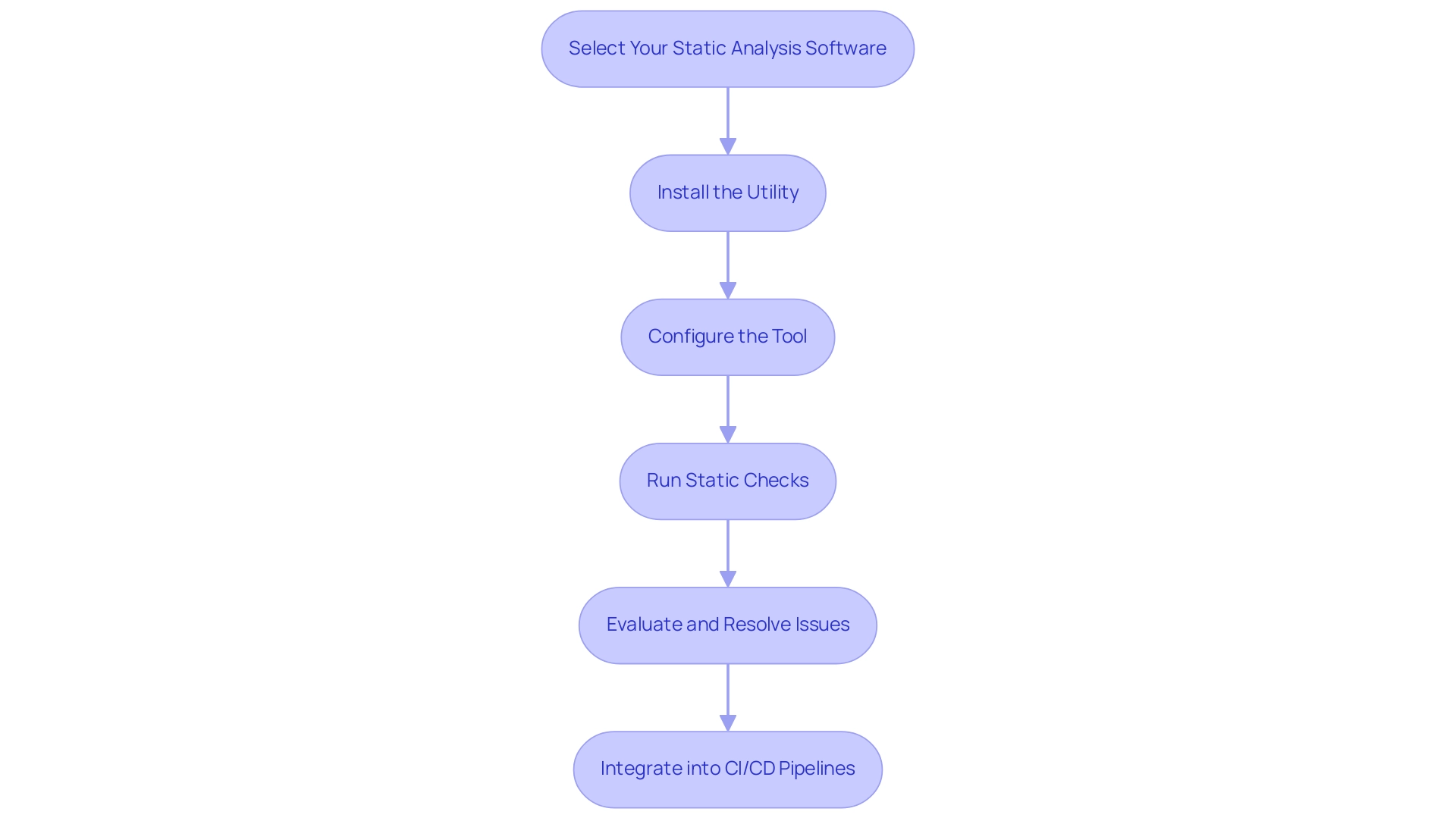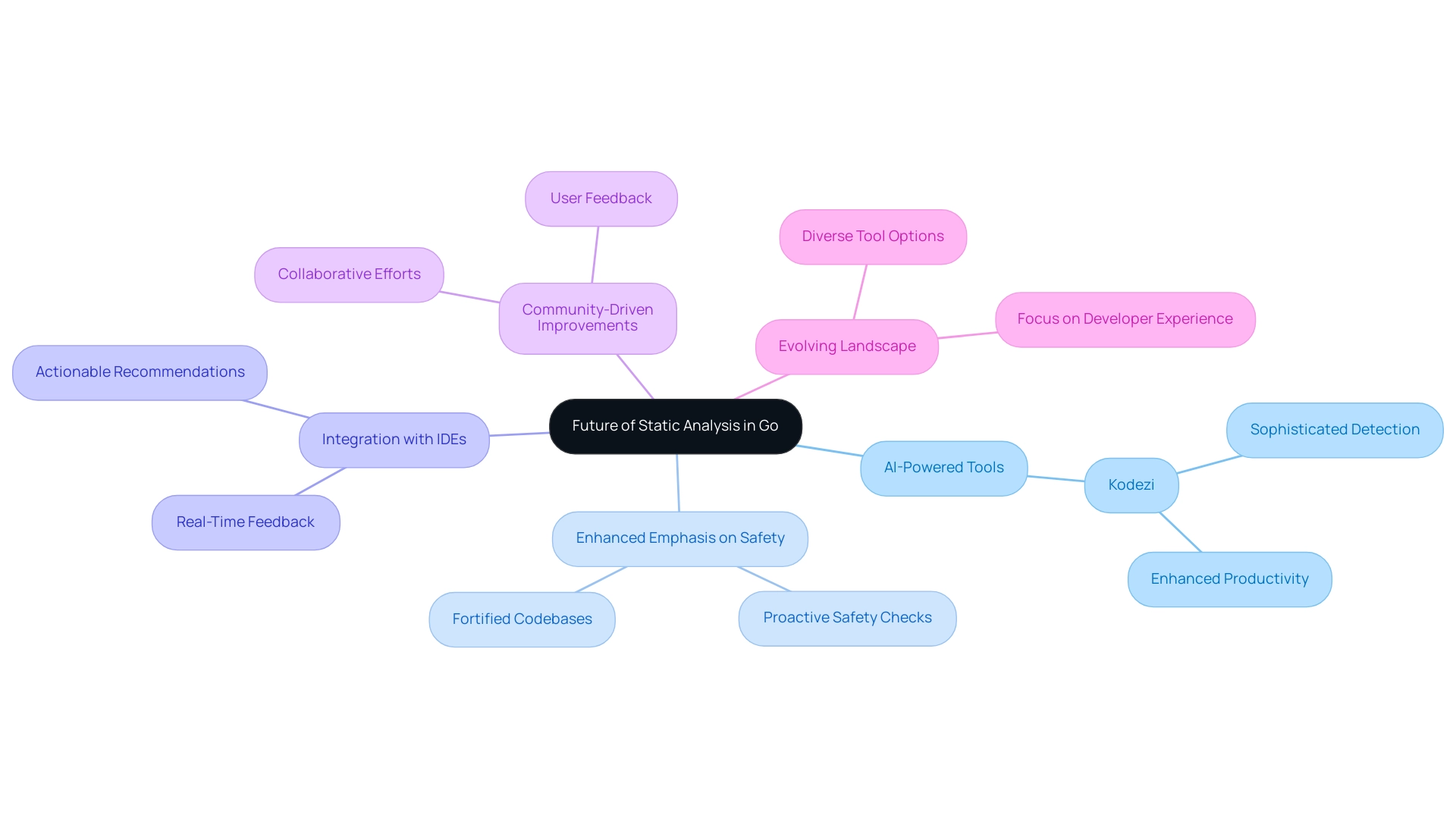Overview
To implement static checks in your Golang projects, start by selecting a suitable static analysis tool, installing it, configuring it to meet your project's needs, and then running the checks to identify and resolve issues. The article outlines a detailed, step-by-step guide that emphasizes the importance of integrating static analysis into the development workflow to enhance code quality, maintainability, and security by catching potential issues early in the development cycle.
Introduction
In the realm of software development, ensuring code quality and security has never been more crucial. As applications grow in complexity, developers are increasingly turning to static analysis as a proactive measure to identify and rectify potential issues before they escalate. This practice not only enhances the reliability of code but also streamlines the development process, allowing teams to focus on innovation rather than troubleshooting.
With tools like Kodezi CLI at their disposal, developers can automate these checks, ensuring that codebases remain robust and efficient. The integration of static analysis into development workflows is not just a trend; it is a necessity for teams aiming to uphold high standards in an ever-evolving technological landscape.
As this article explores, understanding the importance of static analysis, implementing effective strategies, and leveraging the right tools can significantly elevate programming productivity and security.
Understanding Static Analysis in Go: Importance and Benefits
The static check golang is an essential practice in Go programming that allows developers to inspect scripts without running them, uncovering possible mistakes, design flaws, and security weaknesses. Given that the average application contains 526 open-source components, maintaining high-quality software becomes increasingly complex. By integrating static check golang into the development workflow, developers can catch issues early in the cycle, significantly reducing debugging time and enhancing overall productivity.
Resources such as Kodezi CLI enhance this process by autonomously improving codebases and fixing bugs before they reach production, making it a versatile asset for teams focused on enhancing programming productivity. The benefits of using a range of static code evaluation (SCA) tools include:
- Increased code reliability
- Improved adherence to coding standards
- Enhanced collaboration among team members through a cleaner codebase
Keeping up with best practices in static check golang further guarantees long-term software project success.
Furthermore, utilizing its capabilities allows teams to proactively optimize performance bottlenecks, reinforcing the importance of thorough static check golang analysis. With a '5 minute quickstart' and opportunities to 'see a demo,' teams can quickly engage with its features. M&T Bank underscores the importance of these practices, having adopted resources like SonarQube to ensure programming tidiness and adherence—essential for maintaining trust and security in the financial sector.
Techniques such as:
- Abstract Interpretation
- Taint Analysis
- Lexical Analysis
- Data Flow Analysis
serve to identify a range of programming issues, ultimately enhancing quality metrics. Recent industry discussions highlight that integrating SCA and performing a static check golang into the development workflow is essential for maintaining quality and enhancing software security, promoting a culture of excellence, and Kodezi CLI is at the forefront of this movement.

Step-by-Step Guide to Implementing Static Checks in Your Go Projects
- Select Your Static Analysis Software: Begin by identifying a static analysis solution tailored to your project requirements. Notable choices for Go development include 'staticcheck', 'golint', and 'govet', with static check golang providing unique benefits for code quality enhancement.
- Install the Utility: Utilize the Go package manager to install your chosen utility efficiently. For instance, to install 'staticcheck', simply execute:
go get honnef.co/go/tools/cmd/staticcheckin your terminal. - Configure the Tool: Establish a configuration file (e.g.,
.staticcheck.conf) to fine-tune the checks according to your project’s specifications. This customization allows you to selectively enable or disable specific checks, optimizing the functionality’s effectiveness for your needs. - Run Static Checks: Launch the static check golang software on your codebase by executing a command like
staticcheck ./..., which scans all packages within your project. This proactive step involves a static check golang to identify potential issues before they escalate. Keep in mind that while static evaluation resources can enhance software quality, it is secure to profile applications in production; nonetheless, activating certain profiles may lead to a decrease in performance. - Evaluate and Resolve Issues: Review the output produced by the static assessment tool, prioritizing high-severity issues first. Address these findings through restructuring, thereby enhancing your application's overall quality and performance. One can augment this process to look at the receiver of the method and add refactoring logic as needed (using
analysis.Diagnostic). - Integrate into CI/CD Pipelines: Streamline your development process by automating the static check golang evaluations within your CI/CD pipeline. This ensures that checks occur with each commit or pull request, maintaining integrity and minimizing the risk of introducing errors into your production environment. Such integration not only fosters a culture of quality but also aligns with best practices for modern software development. Furthermore, the
analysis testsubpackage offers tools for testing an Analyzer against anticipated diagnostics, further improving your static evaluation efforts.

Choosing the Right Tools for Static Analysis in Go
When choosing a static analysis program for Go, it's essential to consider the unique strengths each option offers, particularly in the areas of automated debugging and security compliance:
- Staticcheck: Renowned for its in-depth checks and performance insights, Staticcheck excels at quickly identifying and resolving bugs and inefficiencies within your software, ensuring rapid issue resolution. Its user-friendly integration and configuration make it a top choice for many developers seeking efficiency. Furthermore, static check golang assists in enhancing performance by identifying sections of the program that can be refactored for improved execution speed.
- Golint: This utility highlights style and programming conventions, ensuring your implementation aligns with Go's best practices. By maintaining stylistic consistency, a static check golang tool such as Golint contributes to the overall readability and maintainability of your projects. A practical example of Golint's effectiveness can be seen in the case study titled 'Empty Line Enforcement,' which demonstrates how enforcing empty lines at the right places can enhance clarity of the programming. Furthermore, Golint encourages compliance with coding standards that indirectly support performance optimization by promoting cleaner code, and a static check golang tool like Govet is integrated into the Go toolchain to uncover common mistakes and potential pitfalls. This instrument is excellent for individuals new to Go development, helping programmers quickly enhance quality with static check golang. It assists in performance optimization by performing a static check golang to identify unnecessary computations and potential memory leaks. However, it's worth noting that the of unused result check in Govet limits its detection capabilities by requiring a comma-separated list of functions whose results must be used.
- Gosec: With a focus on security, Gosec scans your program for potential vulnerabilities, making it indispensable for projects where security is paramount. By prioritizing security early in the development process, including a static check golang, you can mitigate risks effectively and ensure compliance with the latest security best practices. Gosec also emphasizes sections in the software that could be improved to boost security, such as the implementation of secure coding practices that avert common vulnerabilities.
In relation to the most recent Visual Studio launch on 2021-10-12, assessing these resources according to your project's particular requirements, the expertise level of your team, and the kinds of challenges you intend to tackle is essential. As an expert pointed out, with the appropriate analysis resources, you don’t have to compromise on security to provide secure and efficient software. This viewpoint emphasizes the significance of utilizing strong resources such as CLI for improved programming quality and automated testing.
Best Practices for Integrating Static Checks into Your Development Workflow
- Start Small: Initiate your journey by integrating the CLI, an AI-powered resource that autonomously enhances your codebase, into a single project or module. This incremental approach allows you to grasp its benefits and demonstrate early value before expanding its use across your entire codebase.
- Automate Checks: Utilize CI/CD resources alongside other platforms to automate static check golang evaluations, ensuring consistent examination of your code. Automating this process, with the bug analysis capabilities, not only catches issues early in the development cycle but also enhances overall efficiency. As highlighted by SentinelOne, this proactive approach helps prioritize risks and address them swiftly, streamlining your workflow.
- Set Up Alerts: Configure the software to dispatch alerts or reports to developers when issues are detected. This fosters a culture of accountability and continuous improvement, empowering your team to take immediate action on potential code vulnerabilities, crucial for maintaining high standards of pipeline security.
- Regularly Review Configurations: Periodically examine your static assessment tool settings, including its configurations. Adapting to new coding standards or project requirements ensures that your analysis remains relevant and effective, especially by using static check golang to enhance compliance and reporting capabilities that align with industry standards.
- Educate Your Team: Invest in training sessions or resources for your team to understand the significance of using the platform's features effectively. By providing them with the knowledge to interpret results from the platform, you foster a more informed and proactive development environment, which can lead to improved outcomes and reduced lead times for changes—one of the key DORA metrics for measuring excellence in software delivery. Analyzing job duration through reports such as the CICD Job Duration report can provide valuable insights that contribute to these improvements. Furthermore, the application operates as an 'autocorrect for programming,' supporting over 30 languages and presently compatible with Visual Studio Code (Vscode), with intentions to accommodate additional ideas in the future.
The Future of Static Analysis in Go: Trends and Innovations
The future of static check golang is poised to experience revolutionary progress, greatly shaped by resources such as CLI. As B2B engineering teams increasingly pursue autonomous solutions to improve code quality and resolve bugs prior to production, the demand for resources related to static check golang expands. The CLI stands out as a versatile resource that autonomously enhances codebases, ensuring that potential issues are addressed proactively.
Key trends shaping this evolution include:
- AI-Powered Tools: The incorporation of artificial intelligence into static analysis tools, such as Kodezi, is revolutionizing functionality. These instruments provide sophisticated detection capabilities, allowing for the identification of complex code issues and vulnerabilities that traditional methods may overlook, thus enhancing programming productivity.
- Enhanced Emphasis on Safety: With the changing environment of security risks, the static check golang resources prioritize safety checks. The CLI ensures that codebases not only operate efficiently but are fortified against potential vulnerabilities, significantly enhancing overall safety.
- Integration with IDEs: A seamless incorporation of static evaluation resources within Integrated Development Environments (IDEs) is expected, allowing real-time feedback and actionable recommendations as developers write code. The platform enhances the developer experience by promoting immediate improvements and reducing the likelihood of future issues.
- Community-Driven Improvements: The expanding Go community fosters collaborative efforts to refine static analysis tools. The organization actively participates in community events, gathering feedback and insights to enhance its offerings. As noted by users like Augustin, 'The platform has drastically improved our engineering team’s productivity, allowing us to focus on higher-level tasks.' The inclusive nature of the community ensures that tools remain responsive to developers' dynamic needs.
- Evolving Landscape: According to the case study titled "Static Code Analysis Tools in 2024," the landscape is evolving with various options available to meet diverse needs. The integration of AI and an emphasis on developer experience are key trends, with the CLI leading the charge in enhancing productivity and debugging experiences for developers, particularly through the use of static check golang.
As these trends unfold, Kodezi CLI will not only improve code safety but also drive productivity, making it an indispensable component of modern software development. Interested users can explore the tool further with a 5-minute quickstart and see a demo to experience its capabilities firsthand.

Conclusion
Integrating static analysis into the software development process is no longer a luxury but a necessity for teams striving to maintain high standards in code quality and security. The insights shared throughout this article highlight the critical role that tools like Kodezi CLI play in automating and enhancing static code checks, allowing developers to catch potential issues early in the development cycle. By employing a variety of static analysis tools, teams can significantly reduce debugging time, improve collaboration, and ensure adherence to coding standards.
The step-by-step guide provided emphasizes the importance of:
- Selecting the right tools
- Configuring them appropriately
- Integrating them into CI/CD pipelines for seamless operation
As the landscape of software development continues to evolve, the emphasis on security and performance optimization through static analysis becomes increasingly vital. With the advancements in AI-powered tools and real-time feedback mechanisms, the future of static analysis looks promising, offering developers innovative ways to enhance productivity.
Ultimately, harnessing the power of static analysis not only safeguards code integrity but also empowers teams to focus on innovation rather than troubleshooting. By embracing these practices and leveraging tools like Kodezi, development teams can cultivate a culture of excellence, ensuring that they remain competitive in an ever-changing technological landscape. Now is the time to prioritize static analysis as an integral part of the development workflow, paving the way for more efficient, secure, and high-quality software.
Frequently Asked Questions
What is static check golang?
Static check golang is a practice in Go programming that allows developers to inspect scripts without executing them, helping to identify mistakes, design flaws, and security vulnerabilities.
Why is static check golang important for software development?
It helps developers catch issues early in the development cycle, which reduces debugging time and enhances overall productivity, especially considering that applications often contain numerous open-source components.
What are the benefits of using static code evaluation (SCA) tools?
The benefits include increased code reliability, improved adherence to coding standards, and enhanced collaboration among team members through a cleaner codebase.
How can teams optimize performance using static check golang?
By proactively analyzing code, teams can identify and address performance bottlenecks, leading to improved software performance and quality.
What techniques are used in static check golang?
Techniques include Abstract Interpretation, Taint Analysis, Lexical Analysis, and Data Flow Analysis, all aimed at identifying various programming issues.
What are the steps to implement static check golang in a project?
The steps include selecting a static analysis software, installing the utility, configuring the tool, running static checks, evaluating and resolving issues, and integrating the checks into CI/CD pipelines.
What are some popular static analysis tools for Go development?
Notable tools include 'staticcheck', 'golint', and 'govet', with static check golang offering unique benefits for enhancing code quality.
How can static check golang be integrated into CI/CD pipelines?
By automating static check evaluations within the CI/CD pipeline, checks can occur with each commit or pull request, maintaining code integrity and reducing the risk of errors in production.
What should developers prioritize when reviewing static assessment tool outputs?
Developers should prioritize high-severity issues first and address these findings to enhance the application's overall quality and performance.




